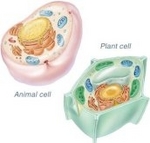
Worksheets and No Prep Teaching Resources
Reading Comprehension Worksheets
Life Science
Plant and Animal Cells

Life Science
 Worksheets and No Prep Teaching Resources Reading Comprehension Worksheets Life Science Plant and Animal Cells |
 Life Science |
| edHelper's suggested reading level: | grades 5 to 8 | |
| Flesch-Kincaid grade level: | 7.95 |
|
Amoeba
By Cindy Grigg |

|
 1 Living things are made of cells. Some things consist of only one cell. They are called unicellular organisms. One of the simplest living things, an amoeba, is made of only one cell. Amoebas (sometimes spelled amebas or amoebae) are too small to be seen without a microscope, but they are commonly found in ponds and lakes. They are "shape-shifters" that sometimes appear as a round blob, sometimes appear to have feet, and sometimes appear to have arms that can surround their food. Amoebas are characterized by their flowing movements, considered to be the most primitive form of animal locomotion, or movement. Some are well-known parasites of plants, animals, and humans. It should be noted that amoeba are not animals; however, they are classified in the protist kingdom.
1 Living things are made of cells. Some things consist of only one cell. They are called unicellular organisms. One of the simplest living things, an amoeba, is made of only one cell. Amoebas (sometimes spelled amebas or amoebae) are too small to be seen without a microscope, but they are commonly found in ponds and lakes. They are "shape-shifters" that sometimes appear as a round blob, sometimes appear to have feet, and sometimes appear to have arms that can surround their food. Amoebas are characterized by their flowing movements, considered to be the most primitive form of animal locomotion, or movement. Some are well-known parasites of plants, animals, and humans. It should be noted that amoeba are not animals; however, they are classified in the protist kingdom. |
Create Weekly Reading Books
Prepare for an entire week at once! |
| Leave your feedback on Amoeba (use this link if you found an error in the story) |
 |
Life Science
|
 |
Plant and Animal Cells
|
 |
Science
|